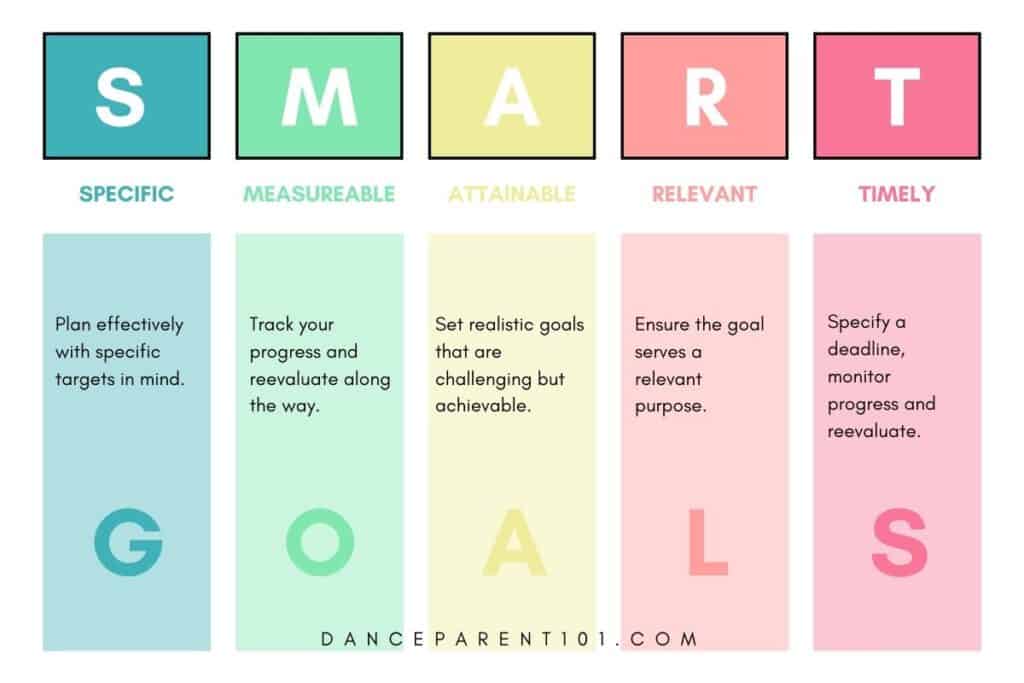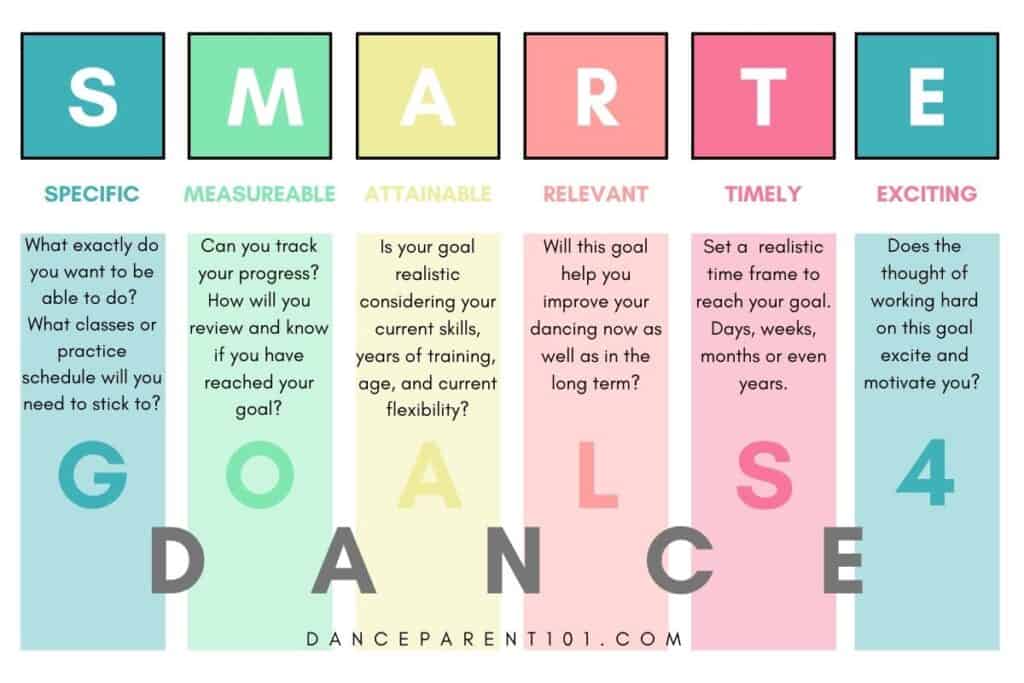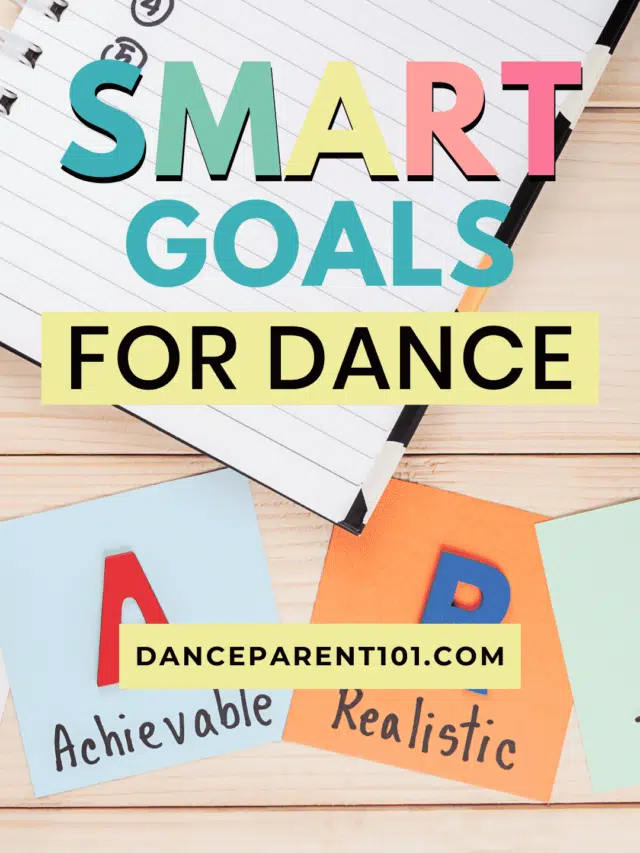By Heidi Williams / Co-Authored & Edited by Samantha Bellerose, B.Ed, Dip.Dance(Performing Arts)
The dance world today is ever-evolving and always advancing. Dancers and Ballerinas everywhere strive every day to push themselves to new heights, to achieve new goals, gain skills, to level up, to be stronger, to become more flexible –to be the best dancer they are capable of being.
Yet, choosing and sticking to a dance goal can sometimes be difficult.
Especially with the increasing amount of dance performances and competitions we see on TV, movies, and social media – it can be hard to know which dance or ballet goals to choose or where to start. I know all this because I am a dancer, teacher, and choreographer and so I wanted to share with you one of the best ways I know to set dance goals and achieve them – SMART Goals!
A SMART goal for dance is S (Specific), M (Measurable), A (Attainable), R (Relevant), and T (Timely). SMART goals help dancers and ballerinas to define exactly what they want to achieve, how they are going to do it, when they will complete it by and why it is important.

As dancers, we have goals, we have ambitions, and we want to see results. However, as the list of what we want to achieve grows, it can start to become overwhelming, especially when we don’t see quick results from our efforts, and it’s easy to become discouraged. How can dancers avoid this? How can we improve our dancing and achieve the goals we set? By setting smarter goals, or as we like to call say at DanceParent101, SMARTe Goals.
What are Smart Goals?
The SMART acronym was originally developed for setting business goals by George Doran in the 1980s and has been adopted by many sports psychologists as an effective goal-setting tool. Using smart goals for dancers or any style such as ballet, hip hop, contemporary or tap dance for example is a great way to ensure your dance goals are achievable, motivating, and give you focus.

What is a SMARTe goal for dance?
A SMARTe goal for dance is:
S (Specific)
M (Measurable)
A (Attainable)
R (Relevant)
T (Timely)
just like a regular smart goal! But we have added an E because we also believe that a smart goal should motivate and excite us!
E (Exciting)
Dancers will constantly be given corrections which we naturally work on during our practice and lessons, but when we give ourselves a goal we need to take the one thing that really matters most, that motivates and excites us to really focus on and level up with!
Think of it as the ultimate formula for success as a dancer. Why is it so helpful? Because it is a framework we can use to revamp our way of approaching tasks and skills, so we can improve faster and work smarter. How does it work? By helping you identify what you want to achieve, then helping you get there. To explain this further, let’s break this down, one letter at a time.

Breaking Down the SMARTe Acronym
S – Specific Goal
You can’t work towards an unspecific goal, or a vague, overly-generalized goal. Trying will only set you up for failure and frustration because you don’t have a clear idea as to what exactly you need to do. Creating a specific goal narrows your focus to the heart of the problem or the root of what you want to accomplish. It forces you to identify exactly what it is you want to achieve. We all want to improve our dance technique, but that goal isn’t specific enough to help, and will often just lead you floundering in frustration, unsure of how to progress and feeling overwhelmed. To make this goal more specific, we could focus on an area where we often receive corrections from a teacher or a competition judge, like not pointing our toes. To make this goal more specific, we could say our goal is to be able to consistently point our toes whenever they leave the floor. How can we make other generalized goals more specific? Let’s put a few to the test.
| NON-SPECIFIC GOAL | SPECIFIC GOAL |
|---|---|
| Have a stronger core. | Be able to consistently engage my transverse abdominus with breath initiation during movement sequences. |
| Have a stronger core. | Be able to increase my daily sit-up count by 5 per day for one month. |
| Have better technique. | Have completely straight legs in my leaps. |
| Have better technique. | Have a straight supporting leg when the foot is on rèlevé. |
M – Measurable Goal
Now that you’ve made your goal specific, you need to be able to track your progress, to measure it. Making a measurable goal is so important because it keeps us accountable, helps us stay on track towards achieving it, and helps encourage us when we see small amounts of progress being made. For dancers, slow-motion video capture is one of the most helpful tools you have at your disposal. You can go frame by frame to see what you are doing right, and what still needs to improve. Another way that you can make a goal measurable is by giving it a quantity –I will do X amount of Y. This is much more helpful than just saying, “I need to do more of Y,” because it gives you something to aim for.
A – Attainable Goal
A smart goal has to be realistic –it has to be something that we can actually attain, otherwise, it won’t happen. Is this goal something that’s within my reach? Is it something that won’t compromise my safety or health? Is it accomplishable? Sometimes we set unrealistic expectations for ourselves before we’ve considered obstacles or limitations, which is why this step is so important. For example, being able to do a side aerial by tomorrow is not an attainable goal if you’ve never done a cartwheel.
R – Relevant Goal
This step is important to consider because it takes into account the “why” of it all. Is your goal relevant in regards to what you want to improve? Will it help you? Is it necessary? Is it needed? Having a straight supporting leg for turns is relevant because it’s the correct form, it’s necessary for successful execution of the turns, and muscles that support the leg and stabilize alignment are activated when the leg is straight.
T – Timely Goal
Having a timely goal is another way of ensuring that it will get done, that you will accomplish it. It gives you a time frame to work within, another way of being able to measure your progress. Saying you want to get your splits on the left side is a good goal, but saying you want to get your splits on the left side by May is a timely goal. It gives you an end date, and it holds you accountable.
E – Exciting Goal
At danceparent101, we think smart goals should also be exciting goals. This brings us back to the why of it all. I want to get my left split by May because I want to be able to do them in the recital dance correctly, and many of my classmates already have their left splits, so it will be exciting for me to accomplish them. Making a goal exciting is a way to remind ourselves that we will benefit from achieving the goal.
How to Use the Formula to Create SMARTe Dance Goals
Now that we’ve gone over what a SMARTe Goal is, let’s put the acronym to work for us by transforming a generalized goal into a SMARTe goal.
Generalized goal: to get better at turns. It’s a good goal, but it’s not very specific. Making this into a smarte goal might look like the following:
S(Specific Goal) – Consistent and clean double en dehor pirouette.
M(Measurable) – Can take video to monitor progress.
A(Attainable) – Yes, I can consistently execute a technically correct single pirouette.
R(Relevant) – Yes. A double pirouette is an important skill to have, and it’s also in my recital dance.
T(Timely) – I will aim to be able to one and a half turns in one month, and a double turn within two months.
E(Exciting) – I want to be able to do a double pirouette so I can progress to the next level, and look good at the recital.
Here’s another generalized goal where we could apply the smarte formula to increasing flexibility. Increasing your flexibility is what all dancers want, but it is not a specific goal. So, to make this actionable/smarte you could do the following:
S (Specific Goal) – Touch head then belly to knees when legs are straight in a seated pike position by mid-year.
M (Measurable) – Can take photos to check progress, or measure the distance of the gap.
A (Attainable) – Yes, I can touch my hands to my feet, and this is the next step.
R (Relevant) – Yes, hamstring flexibility is important to be able to do the splits and other movements.
T (Timely) – I will aim to get my head to my knees in three months, then belly flat on my legs in 6 months.
E (Exciting) – I want to get this skill, as everyone else in my class can already do it! I can’t wait to be able to do it, too.
Putting SMARTe Goals into Practice
So, is making a goal SMARTe as simple as plugging it into the formula? Well, yes and no. Making existing goals smarter is just the beginning, but it’s up to you to follow through with taking the steps to achieve it. Becoming more flexible might be the destination at the end of your journey, but the SMARTe Goals that you set will be your map to get there. Following the aforementioned example, if the first part of the journey was a SMARTe Goal for a stretch that lengthens the hamstrings, then perhaps our subsequent SMARTe Goals will each be a targeted stretch for a different area of the leg or hip. Suddenly, the ambiguous and seemingly unattainable wish for more flexibility isn’t so unattainable anymore. The SMARTe Goals you set would not only give you a direction, but also a plan.
That is why SMARTe Goals are so smart –they help us plan the pathway to our destination, dividing the journey up into small, reasonable steps, so we can take one step at a time. Creating SMARTe Goals helps give us a plan of action. Creating a plan of action gives us a clearer understanding of what is required of us to get there. Narrowing our scope to focus on smaller tasks, doable tasks means we’re less likely to get discouraged, and more likely to stay motivated. Even simply going through the process of making our goals smarter is helpful because it gets us thinking not just about what we want, but how we’re going to get it. When we’re thinking, we’re learning, we’re problem-solving, finding answers. When we’re told what the answer is, we tend to not remember it. When we have to find the answer ourselves, we tend to never forget it.

Why use the SMARTe Goal Formula?
When we force ourselves to get very specific in our goals, it helps us to pinpoint potential areas that need to be strengthened. Perhaps in the progress videos of your double pirouette, you noticed you sometimes wobbled, because of ankle instability. Now you have an opportunity to create some SMARTe Goals that focus on strengthening the intrinsic muscles of the ankle and foot. You no longer have to feel overwhelmed when you see an area of potential weakness because you have a new way to systematically solve it: one SMARTe Goal at a time. It’s truly a simple blueprint that can transform your way of thinking and acting. Instead of seeing problems, you can see possibilities to create solutions.
The concept of setting smart goals might seem overly simplistic, but the cascading effect it can have on our mindset is truly transformative. When we start making progress, little by little with the use of SMARTe Goal setting, we start to build positive momentum. All of the negative self-talk, all the inward “I can’t”s start to become “Oh, but I CAN”s. Suddenly, all the things we looked at as being insurmountable we now see as a potentially fun challenge, because we know we can conquer the big things, one small thing at a time.
Are you ready to set some SMARTe goals?
Ready to help your child or your students set SMARTe Goals? Now you can download our SMARTe Goals worksheet and fill it out at home! Click here to join our newletter and gain access to our library of free printables for dancers which includes a SMARTe Goals poster and worksheet!

